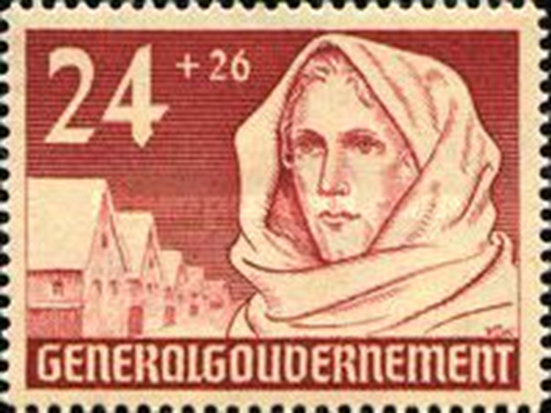Georg Hilz - From Bavaria to Galicia
©Andrzej Philips
While
searching for items related to Galicia, I came across a watercolor painting
titled "Sunday Chat, Dristyow Galicia" dated 15.10.1916, which now
corresponds to Poland, Ukraine, and Slovakia. The artist was identified as G.
Pilz.
The painting Sunday Chat, Dristyow Galicia
Attempts to identify the location
"Dristyow" or the painter "G. Pilz" (literally meaning
"mushroom") were unsuccessful. A closer inspection of the signature
on the painting convinced me that it was actually "G. Hilz." This led
to finding information about the artist Sepp Hilz.
"Old Peasant Woman with
Headscarf" (Study for the painting "Old Woman with Headscarf,"
which brought Hilz his first success at the exhibition at the Haus der
Deutschen Kunst in Munich in 1938)[1].
From 1938 to 1944, Sepp Hilz participated in
the propaganda Great German Art Exhibitions at the Haus der Deutschen Kunst in
Munich, showcasing 22 works, including portraits, nudes, and genre scenes, such
as the iconic "Peasant Venus," "Vanity," and the triptych
"Peasant Trilogy." These works were well-received and approved by
Nazi authorities; Joseph Goebbels bought one, and Adolf Hitler purchased two
others. However, this success had later repercussions. After the war, Hilz was
boycotted. For instance, his participation in a 1951 exhibition in Munich met
with protests. Only a few years later did his undeniable talent overcome these
objections, and from 1956, his paintings returned to exhibition halls, allowing
him to work again as a painter and restorer of church paintings. Today, Hilz's
works are primarily in private collections, with many having reached the United
States post-war. There are few of his works in German museum collections, with
a few pieces in the museum in Bad Aibling. Hilz's art continues to attract
interest, with a significant exhibition held in 1995 on Frauenchiemsee Island
(Lake Chiemsee in Bavaria)[2].
However, the painting dated 15.10.1916 could
not have been by Sepp Hilz, and the "G. Hilz" signature aligns
perfectly with that of his father, Georg Hilz. It turns out that Sepp's father,
Georg Hilz, was also a well-known artist.
Georg
Hilz (1881-1949)
Georg Hilz was a prominent church painter from
Aibling whose works significantly contributed to the artistic heritage of
several churches in Bavaria. His most notable work includes the renovation of
the pilgrimage church of the Holy Cross in Thann in 1936. During this
renovation, Hilz created a fresco on the flat ceiling of the nave depicting the
Battle of the Milvian Bridge in Rome[3],
a significant historical event where Emperor Constantine defeated Maxentius. He
also painted the altarpieces of the side altars which portray Saint Conrad and
Saint Elizabeth[4],[5].
Georg Hilz's painting "Sunday Chat,
Dristyow Galicia”, likely created during the German-Russian campaign in 1916 in
the locality of Dryszczów (now Nadrichne, Ternopil district, Ukraine)[6],
adds significant historical context to the artistic legacy of both Georg and
his son, Sepp Hilz.
The altarpieces of the side altars, which
depict St. Brother Konrad and St. Elisabeth, were created by the Aiblinger
church painter Georg Hilz on the occasion of the renovation in 1936.[7]
Georg
Hilz's Contributions:
- Thann Church Fresco: One of his most notable
works is the fresco on the flat ceiling of the nave of the pilgrimage church of
the Holy Cross in Thann, depicting the Battle of the Milvian Bridge. This work,
created during the 1936 renovation, highlights his ability to blend historical
themes with religious art.
- Altarpieces: He also painted the altarpieces
of the side altars in Thann Church, depicting Saint Conrad and Saint Elizabeth,
further showcasing his skill in religious painting.
Style
and Legacy:
- Artistic Style: Georg Hilz is known for his
detailed and expressive style that vividly brings religious scenes to life,
contributing significantly to the spiritual ambiance of the churches he worked
on.
- Blending Old and New: His work in Thann is
particularly noted for blending old and new artistic elements, preserving the
historical integrity of the site while enhancing its visual appeal for
contemporary worshippers.
Georg Hilz - Village Street with Telephone
Poles Leading to Willing near Bad Aibling[8]
Genealogy
of Georg Hilz[9]:
- Birth: April 7, 1881, Mauern bei
Moosburg, Freising, Upper Bavaria, Germany
- Death: April 25, 1949, Mauern bei
Moosburg, Freising, Upper Bavaria, Germany
- Parents:
- Father: Laurentius Hilz (1850 - 1914)
- Mother: Agatha Lohmaier (1850 - unknown)
- Siblings:
- Maria Hilz (1882 - 1882)
- Andreas Hilz (1883 - 1883)
- Lorenz Hilz (1886 - 1918)
- Franz Xaver Hilz (1887 - 1887)
- Josef Hilz (1898 - 1898)
- Family:
- Wife: Maria Deckinger (1870 - unknown)
- Son: Josef Georg Franz "Sepp" Hilz (1906 - 1967)
Conclusion:
Georg Hilz's work, characterized by its
detailed and expressive style, remains influential, with significant
contributions to Bavarian church art. His legacy, continued by his son Sepp
Hilz, highlights the importance of preserving cultural and historical elements
through art.
[1] https://www.gailerfineartchiemsee.de/
[2] https://www.agraart.pl/
[3] The Battle
of the Milvian Bridge took place between the Roman
Emperors Constantine I and Maxentius on 28 October 312 AD.
It takes its name from the Milvian Bridge, an important route over
the Tiber. Constantine won the battle and started on the path that led him
to end the Tetrarchy and become the sole ruler of the Roman
Empire. Maxentius drowned in the Tiber during the battle; his body was later
taken from the river and decapitated, and his head was paraded through the
streets of Rome on the day following the
battle before being taken to Africa.
The Milvian Bridge is a bridge over the Tiber in northern Rome, Italy. It was an economically and strategically important bridge
in the era of the Roman Empire.
[4] Heimat am Inn,
gegruendet von Anton Demp, Rosenheim 1951
[5] https://www.erzbistum-muenchen.de/pfarrei/stadtkirche-bad-aibling/cont/61646
[6] It is unlikely
that this is Dryszczów (now Podlisne, Chortkiv district, Ukraine).
[7]
https://www.erzbistum-muenchen.de/pfarrei/stadtkirche-bad-aibling/cont/61646
[8] Picture public domain,
https://artvee.com/
[9] http://www.genealogie-oberbayern.de











.jfif)












